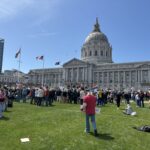As each minute passed after 8 p.m. CST on Monday, November 24, 2014, the more than 200 protestors huddled in front of the Ferguson Police Department ignored the chilly evening temperature and waited in anticipation of St. Louis County Prosecutor Robert McColluch’s press conference. McColluch was set to announce whether or not a grand jury decided to indict white police officer Darren Wilson for shooting unarmed black teenager Michael Brown on August 8, 2014. Thousands of people across the country stayed tuned to The New York Times’ live broadcast of the press conference, bracing themselves for the inevitable chaos to follow.
Finally, McColluch stepped up to the podium and announced, “After their exhaustive review, the grand jury deliberated and made their final decision. They determined that no probable cause exists to file any charges against officer Wilson and return a no true on each of the five indictments.”
When McColluch said those words, he set off a series of protests around the country. Protests regarding Brown’s shooting were not uncommon, as his death sparked a national debate over police violence, particularly against racial minorities.
While many activists compared Brown’s case to the 2012 shooting in Florida of another unarmed black teen, 17-year-old Trayvon Martin, by civilian George Zimmerman (who was acquitted), advocates for Wilson argued Wilson was defending himself. Wilson’s supporters even raised thousands of dollars in donations online for his defense.
Shortly after McColluch announced the grand jury’s decision, Ferguson, a town rarely talked about prior to Brown’s death, erupted into chaos. Hundreds marched in protest of the grand jury’s decision, many holding their hands up, a gesture that has been popular in protests regarding the shooting because some witnesses stated Brown held his hands up but was shot by Wilson anyway.
Within a few hours of McColluch’s announcement, fires broke out and many protestors, both in Ferguson and other cities such as Boston, say they were pepper sprayed or arrested despite the fact that they were protesting peacefully.
In local Oakland, CA, many protests also took place, including a protest on Friday, November 28, 2014, where protestors blocked the doors of BART on Black Friday.
The issue, though, is larger than the death of Michael Brown. As popular statistics group FiveThirtyEight pointed out on their website, in 2010, the most recent year data was available, the U.S. Justice Department states 165,000 cases were presented to grand juries nationwide. Grand juries declined to indict in only 11 of those cases, making what happened in Ferguson extraordinarily rare.
Brown’s case has also highlighted an epidemic of violence against black people. In fact, according to the CDC, homicide is the leading cause of death among black men ages 15-34.
Violence by police officers against black men is also not isolated to Ferguson, as illustrated in the recent November 22, 2014 shooting of another unarmed black boy, twelve-year-old Tamir Rice, by police officer Timothy Loehmann. And as FiveThirtyEight pointed out, there is no telling exactly how many people of any race are killed by police officers in a given year because no one is officially tracking it nationally, meaning there could be many cases no one has heard about.
Protests, including dozens of “die-ins” in which protestors play dead to draw attention to Brown’s death and the fact that his body was left lying on the street for an extended period of time, continue across the country more than a week after the grand jury’s decision was announced.
However, if future protestors in Ferguson are arrested, they will not have to worry about their arresting officer being Darren Wilson.
On November 29, 2014, Wilson’s lawyer confirmed to CNN that Wilson decided to resign. He had spent the prior few months following the shooting on paid administrative leave.
In an interview with St. Louis Post-Dispatch, Wilson said resigning was “the hardest thing I’ve ever had to do.”
TAMIR RICE
Tamir Rice, a 12-year-old black boy, was shot and killed on November 22, 2014 by a policeman in Cleveland, Ohio. Rice was playing alone in the snow on a swing. He had an Airsoft BB gun missing its orange muzzle cap; orange normally signals a toy gun. The 911 caller who brought Rice to the police’s attention added that the gun was “probably fake.” The dispatcher failed to mention this lack of certainty to the officers, and furthermore asked twice if the child was black or white before sending officers to investigate. Rice is seen reaching for his waistband before being shot; Tim Loehmann, the rookie officer who shot Rice, reportedly thought the boy was around 20. A police report claims that the police called several times for Rice to put his hands up, and that Rice failed to comply; their claim has been entirely refuted by video footage that shows that Loehmann shot Rice two seconds after leaving his vehicle. Rice lay in the snow for four minutes before dying, and the police offered no medical attention. Loehmann’s father excuses his son, maintaining that Loehmann “had no choice.” The father also offered that his son had recently transferred to Rice’s neighborhood and relished the opportunity for more action. Many have been let down by coverage of the incident by local and national news. Failing to find dirt on Tamir Rice himself, media outlets have reported on histories of violence in Rice’s family and neighborhood, or on the childhood and family history of the officer who killed him. All of this sadly falls in line with common trends around reporting the deaths of young black people.
Rice’s funeral was held on Wednesday, December 3.



